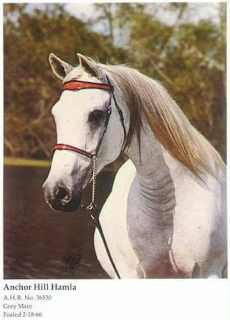*Nabilahh
was my favorite of the Farasha daughters, as I believe she was a very
consistent producer of horses that in turn, created influential
families. Gleannloch imported ten Anter daughters from Egypt. One of
these ten Anter daughters was the mare, *Nabilahh. I can't think of a
more powerful statement, that would underscore the importance of Anter
and his daughter, *Nabilahh, than a foundation breeder like Gleannloch
purchasing a large number of these horses.
Nabilahh produced 8
daughters:
- Bint Nabilahh in 1970
- Lohelia (*Morafic) in 1971
- Nagliah in 1972
- Neama in 1976
- AK Aliha (*Sakr) in 1977
- AK Bint Nabilahh (*Ibn Moniet El Nefous) in 1979
- AK Rafaayah (*Ibn Moniet El Nefous) in 1980
- Frabilahh (The Egyptian Prince) in 1984
It
is interesting to point out the Bentwood-bred mare, AK Bint Nabilahh,
who produced Classic Aisha by the Ruminaja Ali son, Alidaar (who
provides an additional line to Farasha through his dam, Bint Magidaa)
and SF Egyptian Dove, sired by ET Crown Prince. I have not seen this
mare SF Egyptian Dove but I am curious to see how much she may resemble
Maar Bilahh, as she has the line to Maar Hala through her sire, as well
as a double does of *Nabilahh. SF Egyptian Dove has produced 3 mares
that I know of: Ghazalat Bouznika by Imperial Imdal and two daughters by
Imperial Mashhar (this stallion has Imperial Fanniya in his dam line,
who was sired by *Faleh, a Farasha son and through the sire, Imperial
Madheen, has an additional line to Farasha, through Galal and a line
through Yosreia through Mohga): Mouniat Bouznika and Nabilah Bouznika,
who should be somewhere around 10 years of age by now. The mare AK
Rafaayah, was bred to the *Farazdac son, Shah el Sun to produce the mare
N-Amora in 1992. This is an interesting mare to consider, as she
carries Farasha on the top of her pedigree and the tail female. She in
turn was bred to the predominantly Dahman stallion, Shaikh el Shamal, to
produce the mare Nabilat el Sheruk, 10 years ago.
In
the above paragraph, I mentioned the Alidaar-sired mare Classic Aisha
and I must make mention of another Alidaar daughter out of The Egyptian
Prince, Frabilahh, who produced Classic Farida. She has produced 2 sons
by Ansata Hejazi and a son by the *Ibn El Mareekh son, Baahir.
The
mare, Lohelia, has been prolific in her production of daughters,
including the Bentwood mare, AK Ahliyeh, who produced a son by *Serag,
Ahsen El Serag, owned by Al and Judi Parks of Al Abbasiyah International. While there have been horses produced with
multiple lines to Farasha or Yosreia, it is interesting to find a
stallion with Anter in the sire line, relatively close. AK Ahliyeh, when
bred to Imperial Imdal, produced Kirmali in 1988. I saw this mare at
the Newcomer's farm, Conestoga Run in Pennsylvania and was awestruck by what was for me, a
statuesque, elegant and wonderfully leggy, nice-moving mare. I was
really surprised by Kirmali and her size, reminiscent of Sid Abouhom. She was shown with some
success in hunter-under-saddle classes. Lohelia also produced AK Rasafah
by Ansata Abbas Pasha, RXR Lia Moniet by AK El Zahra Moniet (Maarena
blood here on the bottom) and Shahelia by Shaikh Al Badi.
Nagliah,
bred twice to *Zaghloul, produced the stong-bodied Asmarr and Naheed, Taira by *Soufian,
Buukura by Al Metrabbi, Nagiba by Ibn El Hassan and Bint Nagliah by
Thee Desperado.
Neama
was bred to The Minstril twice, to produce the full sisters: Najimah
and Neena, as well as *Soufian, to produce the mare Qastal.
For me, the
most outstanding mare of the Farasha family is Maar Bilahh, another
Rancho Bulakenyo-bred horse, a daughter of El Halimaar, out of the
*Nabilahh daughter by *Morafic, Bint Nabilahh. If Bint Nabilahh had only
produced Maar Bilahh, she would have been forever remembered,however, she also produced two mares by Shaikh Al
Badi: Ruminaja Nadia (she in turn produced Mashwara by Bay Halima and
Sharifa Moniet by Moniet El Sharaf) and Ruminaja Nahjat.




























